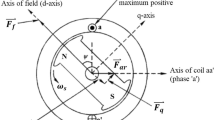Abstract
Wind energy is an abundant and naturally occurring source of energy that is being widely researched and implemented in recent times on a global scale. Quality of power generated from these renewable energy systems greatly determines the efficiency of such implementations. This research paper investigates and proposes a hybrid control scheme for reducing the total harmonic distortion which severely degrades the quality of power from energy conversion systems. The proposed hybrid space vector modulation scheme is a variant and improvement of the conventional PWM schemes. The produce more fundamental components with least harmonics by combining the merits of sinusoidal PWM and triangular carrier signal. The proposed modulation scheme is implemented in a closed loop PI controller scheme and results have been compared against three variants of PWM techniques namely sinusoidal, random and space vector PWM techniques and a drastic reduction in THD and power spectral density is observed justifying the superior performance of the proposed hybrid control scheme.













Similar content being viewed by others
References
Blaabjerg F, Ma K (2013) Future on power electronics for wind turbine systems. IEEE J Emerg Sel Top Power Electron 1(3):139–152
Tozzi G, Elsied M, Mabwe A, Onambele C, Pugi L (2017) Enhanced space vector PWM for six to three-phase matrix converter interfacing PMSG with the grid. In: IEEE. pp 1933–1940
Yaramasu V, Wu B (2014) Predictive control of a three-level boost converter and an NPC inverter for high-power PMSG-based medium voltage wind energy conversion systems. IEEE Trans Power Electron 29(10):5308–5322
Bose BK (2002) Modern power electronics and AC drives. Prentice-Hall PTR, Upper Saddle River, pp 210–224
Sharma S, Singh B (2012) Control of permanent magnet synchronous generator-based stand-alone wind energy conversion system. IET Power Electron 5(8):1519–1526
Dehghanzadeh AR, Behjat V, Banaei MR (2016) Double input Z-source inverter applicable in dual-star PMSG based wind turbine. Electr Power Energy 82:49–57
Barrado-Rodrigo JA, Talpone JI, Martinez-Salamero L (2017) Variable-speed wind energy conversion system based on a dual stator-winding induction generator. IET Renew Power Gener 11(1):73–80
Biweta M, Mamo M (2017) Closed loop control strategy of back to back PWM converter fed by PMSG using PLECS toolbox on MATLAB/simulink for wind energy application. In: IEEE Africon proceedings. pp 1313–1318
Yenduri K, Sensarma P (2012) Improved maximum power extraction strategy for PMSG based wind energy conversion system. IET, Stevenage
Jia F, Cai X, Lou Y, Li Z (2017) Interfacing technique and hardware-in-loop simulation of real-time co-simulation platform for wind energy conversion system. IET Gener Transm Distrib 11(12):3030–3038
Zammit D, Spiteri Staines C, Micallef A, Apap M (2018) MPPT with current control for a PMSG small wind turbine in a grid-connected dc microgrid. In: Battisti L, Ricci M (eds) Wind energy exploitation in urban environment. TUrbWind 2017. Green energy and technology. Springer, Cham
Zhang R, Prasad VH, Boroyevich D, Lee FC (2002) Three-dimensional space vector modulation for four-leg voltage-source converters. IEEE Trans Ind Power Electr 17(3):314–326
Zhang J, Chen Z, Cheng M (2007) Design and comparison of a novel stator interior permanent magnet generator for direct-drive wind turbines. IET Renew Power Gener 1(4):203–210
Xing P, Fu L, Wang G, Wang Y, Zhang Y (2018) A compositive control method of low-voltage ride through for PMSG-based wind turbine generator system. IET Gener Transm Distrib 12(1):117–125
Rahimi M (2017) Modeling, control and stability analysis of grid connected PMSG based wind turbine assisted with diode rectifier and boost converter. Electr Power Energy Syst 93:84–96
Sahajwani M, Patel S (2016) A review on modern pulse width modulation techniques based inverters. Int J Adv Res Electr Electron Instrum Eng 5(9):7233–7237
Krishnakumar C, Muhilan P, Sathiskumar M, Sakthivel M (2015) A new random PWM technique for conducted-EMI mitigation on Cuk converter. J Electr Eng Technol 10:916–924
Venkata Y, Apparao D, Mario JD, Samir K, Bin Wu (2017) PMSG-based wind energy conversion systems: survey on power converters and controls. IET—Electr Power Appl 11(6):956–968
Kouro S, Malinowski M, Gopakumar K et al (2010) Recent advances and industrial applications of multilevel converters. IEEE Trans Ind Electron 57(8):2553–2580
Chen X, Zhao S, Wang Y, Li M (2018) Harmonics elimination in permanent magnet synchronous generator with current injection at DC side. In: Zhu Q, Na J, Wu X (eds) Innovative techniques and applications of modelling, identification and control. Springer, Berlin, pp 147–168
Sahu A, Gupta S, Singh VK, Bhoi AK, Garg A, Sherpa KS (2018) Design of permanent magnet synchronous generator for wind energy conversion system. In: SenGupta S, Zobaa A, Sherpa K, Bhoi A (eds) Advances in smart grid and renewable energy. Lecture notes in electrical engineering, vol 435. Springer, Singapore
Boopathi R, Muthukumar P, Melbamary P, Jeevananthan S (2012) Investigations on harmonic spreading effects of SVPWM switching patterns in VSI fed AC drives. In: IEEE international conference on advances in engineering, science and management, pp 651–656
Author information
Authors and Affiliations
Corresponding author
Rights and permissions
About this article
Cite this article
Boopathi, R., Jayanthi, R. & Ansari, M.M.T. Power quality improvement in wind energy conversion system using hybrid SVPWM inverter control technique for THD reduction. Int. J. Dynam. Control 8, 592–603 (2020). https://doi.org/10.1007/s40435-019-00556-3
Received:
Revised:
Accepted:
Published:
Issue Date:
DOI: https://doi.org/10.1007/s40435-019-00556-3




